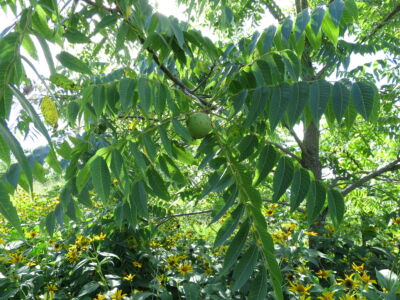Walnut Toxicity
Black walnut (Juglans nigra) is a valuable native hardwood tree, found in deciduous forests in southern Ontario. The nuts are an important food source for wildlife and the wood provides valuable lumber. In a garden setting, the large fruit can be considered a nuisance, but the bigger concern is walnut toxicity. Black walnut trees produce a toxic substance, known as juglone. While many plants can tolerate the juglone and grow well near black walnuts, others are negatively impacted by even small amounts of this chemical. Many horticultural flowers and garden vegetables are prone to damage since they have not evolved with this species.
Other trees closely related to black walnut, including butternut, English walnut, and hickories, also produce juglone. However, they generate it at low concentrations and toxicity to other plants is rarely observed.
Many plants produce chemicals to suppress other plants, a strategy called allelopathy. The term refers to a relationship between plants in which one species produces a substance that inhibits the growth of other species nearby. The production of juglone is a protective response by the tree to assure its survival from competition and to enhance its chances of reproduction.
Juglone occurs naturally in all parts of black walnut trees, especially in the buds, nut hulls and roots. The leaves contain smaller quantities of this chemical, which leaches into the soil after the leaves fall and decompose. The greatest concentration of juglone is directly under the tree’s canopy, but the toxic effects can extend beyond the tree’s dripline. Damage to sensitive plants can extend up to 18 metres away from the trunk of a mature walnut.
Toxic effects vary considerably. Some plants can grow for several weeks or years near a walnut before injuries occur. Plants adversely affected may shows signs of decline such as stunted growth, reduced vigor, and lack of flower development. In more severe cases, yellow or brown twisted leaves, wilting, and eventually death can be observed. Keep in mind there are other factors that impact the health of plants and those should also be considered before black walnut toxicity is assumed to be the problem. Symptoms of walnut toxicity can occur very rapidly and are not reversible.
Since decaying roots continue to release juglone, the toxins can persist in the soil for several years after a walnut tree has been removed. Signs of plant decline will linger until all the roots have decomposed and the juglone is broken down.
Juglone is poorly soluble in water and does not move far in the soil. From observations, increased toxicity seems to be associated with poorly aerated, wet soils with limited microbial activity and organic matter. Since well-drained soils with a healthy population of microbes can accelerate the metabolic decomposition of juglone, any steps to improve soil drainage, such as adding organic matter, should help minimize issues.
Below are some general tips for successfully planting around black walnuts.
- Plant species that are tolerant to black walnuts.
- Build raised beds to grow vegetables.
- Improve soil drainage.
- Do not decompose walnut leaves and hulls near sensitive plants.
- Avoid using wood chips containing walnut bark, wood, hulls, or leaves to mulch trees and gardens.
Many factors affect juglone sensitivity including level of contact, health of the plants, soil environment, and overall site conditions. This webpage has a list of some native trees and shrubs that are tolerant to juglone and others that are sensitive to it. This list should be used for guidance only since few plants have been experimentally tested for tolerance or sensitivity to juglone.
Contact: Brenda Gallagher, Forestry Technician


